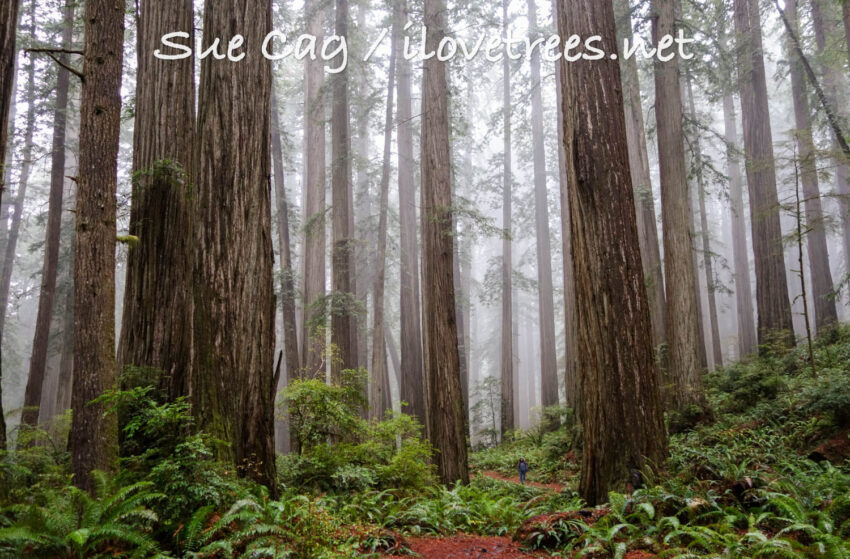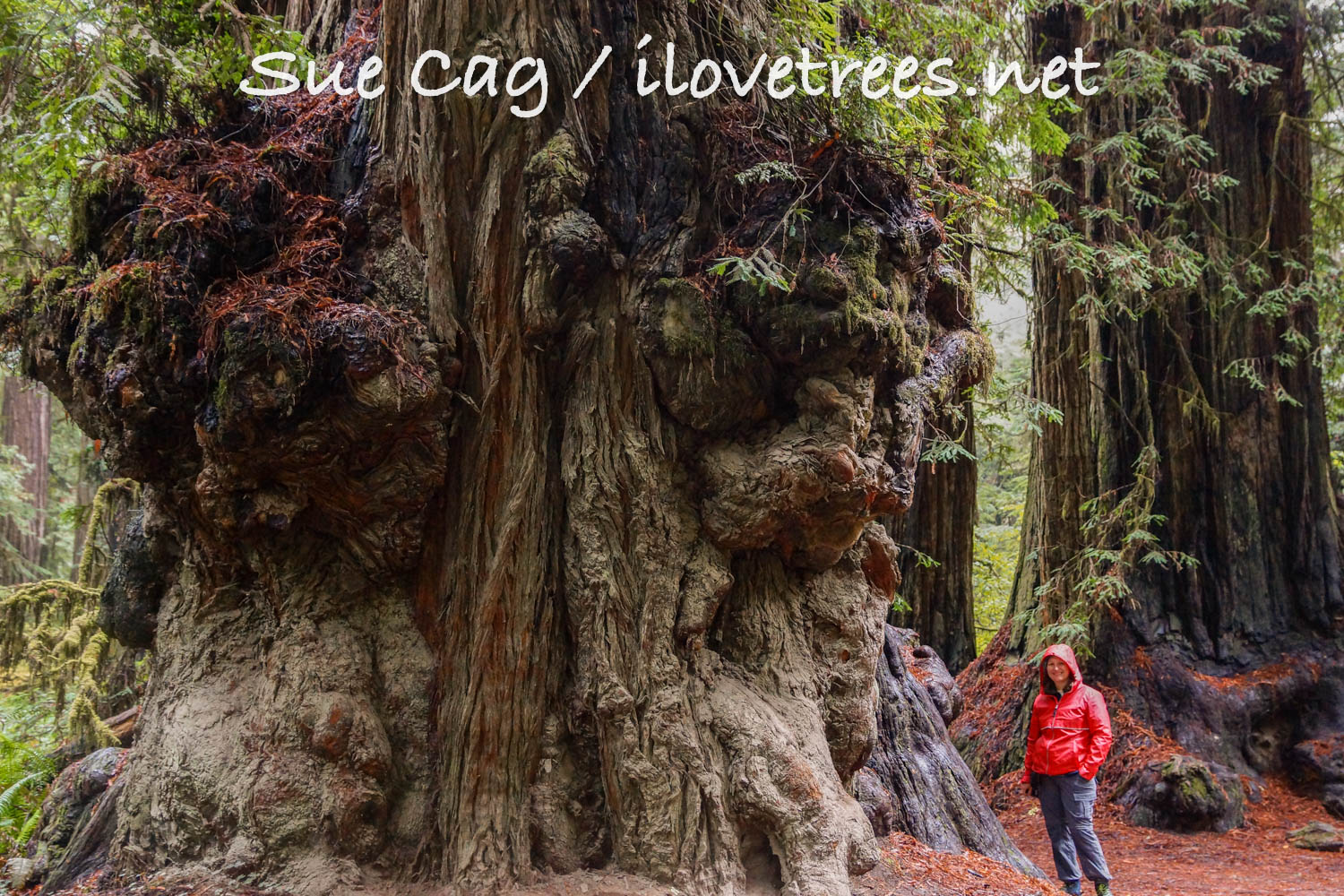I don’t know where to look. The rough trunks form a wall on either side of the trail and I want to study their furrowed bark, marvel at the ferns growing out of the duff, and see how far into the dark forest my eyes will allow me access. At the same time, I long to look upward, to crane my neck to the point of dizziness in the hopes of catching a glimpse of the canopy three hundred feet or more above where I stand. I feel small, overwhelmed, and unsure of what exactly I am seeing. The mist moves like a cloak around these imposing giants. I take a deep breath of the moist air. I am in a new kind of heaven. I am in the redwoods.
Perhaps my favorite trail of all-time, anywhere, is a walk that winds for several miles through the most beautiful redwood grove I have ever seen. The scenery is otherworldly even before reaching the trailhead, with sentinels lined up shoulder-to-shoulder along the road. Those first few steps onto the trail, however, make me gasp every time. On either side of the path are enormous moss-painted redwood trees with chest-high sword ferns growing out of the duff beneath. I feel as if I am crossing a threshold into another time, half-expecting a brontosaurus to poke her head out with a mouth full of lush underbrush.
The walk is easy to start, giving me plenty of opportunity to look around. To my left is a hill of gnarled giants extending up the ridge. To my right is a ravine filled with impressive large trees mixed with fallen giants laid to rest among the ferns. This is a true old-growth forest that includes ancients who are still standing, those who have fallen and begun to sustain new life, and young trees beginning anew. It is all I can do to not spin myself in dizzying circles and plummet into the old-growth ravine as I try to take in everything around me, straining to see the canopy through the ever-present mist. Occasionally the mist shifts and a sunbeam finds its way through the dense canopy like an arm of the divine. Around every curve is a scene even more beautiful than the last.
A variety of fungi sprout from moss-covered logs, and as I get deeper into the forest I hear the clear chirps of a pacific wren and the syncopated pecking of a red-bellied sapsucker. Sound is brighter here too, reverberating inside the tall-walled forest. One of my favorite spots on the trail is actually a grove of younger trees. The mulch-coated trail winds through these “smaller” but dense trees that hug the slope on either side of the trail. The forest floor is a carpet of sorrel, who turn their leafed faces to the sun and illuminate the straight-standing tree towers.
Part of what makes the redwoods feel like such a magical dreamland is the lush diversity of the forest itself. This is especially apparent during the second half of the trail, when the imposing giants are accompanied by a variety of other impressive trees. As the path winds closer to a creek, I notice impressive spruce trees, who in any other context would be the stars of the show. They are large and old, their scaly bark flecked with gray and wrapped in green moss. Big leaf maple trees glisten in the sunlight, their yellow autumn leaves punctuating the spongy forest floor and providing a pop of color as I glance upward toward the forest canopy. As I continue along, I do a double take when I realize that some of the trees I assumed were redwoods are actually western redcedars. In this beautiful forest all of the trees are large, coated with emerald moss, and I’m trying to look in every direction at once (in looking up and sideways I neglected looking down and almost stepped on a banana slug on more than one occasion).
I take a short spur up a steep hill, sliding a bit in the mud, to visit a notable tree. Although arguably a double tree and thus not eligible for the record books, this particular tree has the demeanor of an old sage and is clearly the sentinel of this particular ridgeline. An anxious chickaree seems to agree with me, chattering in alarm the entire time I linger and admire the magnificent giant. I run my fingers along the wet, rough bark. I wonder what stories this tree has to tell.
To the chickaree’s relief, I finally begin to head back. While I generally prefer loop trails rather than out-and-backs, this particular walk is a notable exception. Even when walking slowly and swiveling my neck, I cannot possibly see everything. On the way back, I get a second chance and an opportunity to explore new angles of the forest. I notice for the first time behemoths rising in front of me that I somehow neglected when I passed by the first time. The sun begins its descent in the sky, lending an amber hue to the forest. Everything is once again new and different. The colors are deep and rich, chipmunks play in shadow, the creek gurgles, the maples are fluorescent. I get back to the trailhead just before dusk, as the redwoods along the road loom large under the nascent cloak of darkness.
There used to be over two million acres of magnificent coast redwood forest. Now we have a patchwork of parks consisting of small parcels that were saved due to the efforts of conservationists. Not too long ago, this accessible paradise was destined for clear-cutting. There are lands now in similar peril that need saving by individuals like you. Enjoy a hike through these magnificent trees and enjoy the magical fairyland that lies beyond the pavement, beyond the noise of traffic, even beyond our sensory perception. The redwoods are a beautiful reminder from the past but they are also a warning: do not decimate the things of beauty in this world, for those are the things that make our souls sing.
Addendum/Big tree public service announcement: Redwoods are not giant sequoias. The confusion lies partly in the fact that the redwoods are scientifically named sequoia sempervirens. The giant sequoias, sequoiadendron giganteum, are indeed relatives, but just as you would get annoyed if someone confused you with a chimpanzee, such is the case with these trees. In the most basic of terms, the redwoods are extremely tall and located on the coast whereas the sequoias are also tall but more so wide and located inland in the Sierra Nevada mountains.
About the Author:
Kim Dicso is a singer-songwriter, multi-instrumentalist, prosaist, hiker, traveler, vegan, and contributing author of nature writing for ilovetrees.net. Find her music at folkstar.net.
All photos by Sue Cag and Kim Dicso. All Rights Reserved. Photos may not be used without permission.



